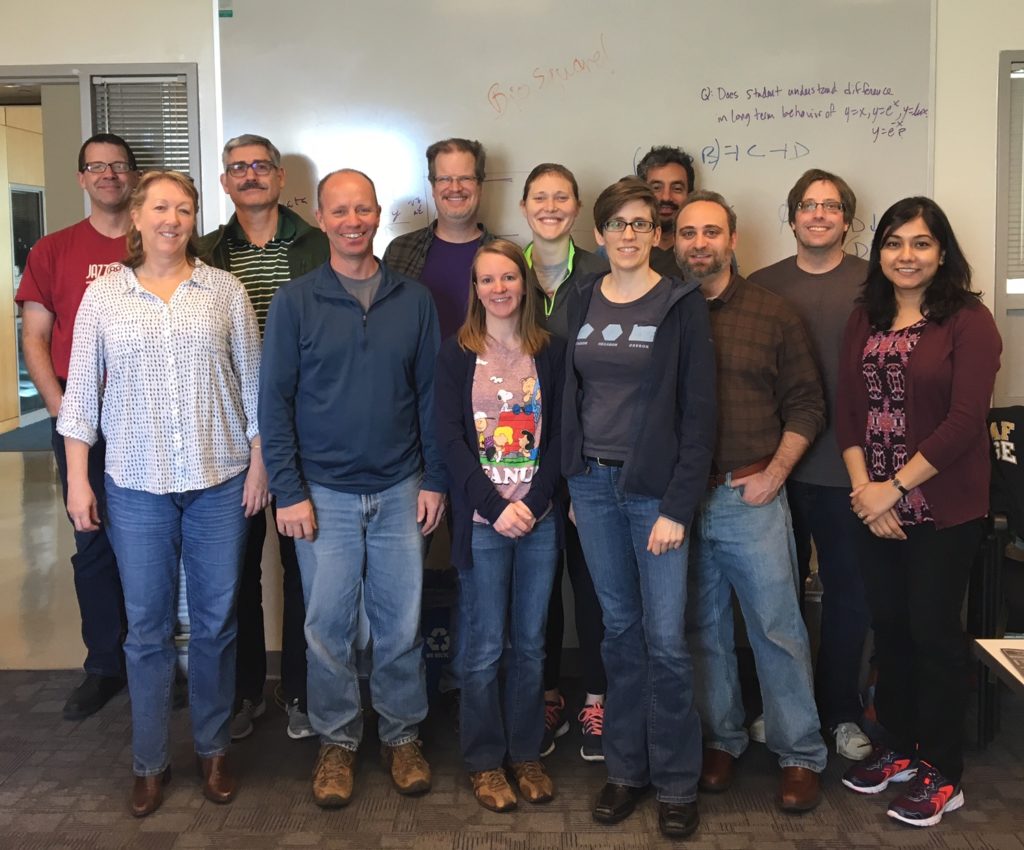Creation of the BioSQuaRE Assessment Instrument


For instructors: If you are an instructor interested in considering the use of BioSQuARE with your students, please complete this brief on-line survey, which gathers some basic contact information (e.g., institutional type, departmental listing, class size, range of students, etc.). One of the BioSQuARE team will then follow-up with additional information and instruction.
We will provide faculty liaisons with a report that summarizes the responses of their students. Please note, these summaries will be aggregated to the course or institution level and will only be provided if the number of students completing BioSQuaRE is large enough to protect individual students’ anonymity. Although in the early stages, we will also show comparisons of individual courses to the averages of all students who have completed the instrument.
Since the intent of the instrument is to gather information about students who enter and complete a biology major, we aim to gather responses during the early portion of each semester (e.g. late August through September; and again mid-January through February).
The research done to develop BioSQuaRE has been approved by the Institutional Review Boards (IRB) of the University of Minnesota and each of the collaborating institutions. Participation by students is voluntary and is guided by the consent form at [this link]. Instructors or departments who use the BioSQuaRE to assess student performance and inform curricular conversations do not need IRB approval.
Please direct questions you might have to [email protected].
Background. The Biology Science Quantitative Reasoning Exam (BioSQuaRE) is a survey instrument to assess the quantitative readiness of students planning on majoring in biology or the life sciences. The creation of this instrument was motivated by the myriad reports documenting both the increasingly quantitative nature of biological research and the potential that a “mathematics gap” of entering students might be leading many, despite their interest in STEM (Science, Technology, Engineering, and Mathematics), to choose a different career path (PCAST, 2012). In addition, this instrument can be used to assess the quantitative skills of upper-level students, which might promote additional conversations about curricula across departments.
A Collaborative Effort. A collaboration involving six institutions (Macalester, Bryn Mawr, Oberlin, St. Olaf, Lewis and Clark, and the Claremont Colleges) along with individuals associated with the Educational Psychology Department at the University of Minnesota and the Statistics Department at Iowa State University led to the iterative development of the BioSQuaRE instrument.
Instrument Development. The current version of BioSQuaRE includes items that assess students’ understanding of the following quantitative content: data visualization, algebra and functions, statistics, modeling, and probability.
These efforts were supported by a Science Education mini-grant from the Howard Hughes Medical Institute (HHMI).
Presentations of BioSQuaRE Instrument Development
|
1. Quantitative Undergraduate Biology Education Summit. Raleigh, North Carolina; February 6-8, 2015. “Past and Future of BioSQuaRE, an instrument developed by the Q6 Consortium”. Talk by Paul Overvoorde (Macalester College) |
|
2. Understanding Interventions Conference San Diego, CA; May 15-17, 2015. “Defining the Quantitative and Computational Skills of Incoming Biology Students”. Talk by Paul Overvoorde (Macalester College) |
|
3. Ohio Project Kaleidoscope Increasing STEM Success in Higher Education. Otterbein University, Westerville, OH; May 16, 2015. “Assessing Quantitative Skills Preparedness and Learning”. Talk by Jason Belitsky, Marcelo Vinces, and Nancy Darling (Oberlin College) |
|
4. HHMI Constellation Studio A meeting; June 2015. “STEM Persistence and Trajectories of St Olaf Students”. Poster by Matt Richey (St. Olaf College) “Defining the Quantitative Skills of Incoming Biology Students”. Poster by Greg Davis (Bryn Mawr College) and Liz Stanhope (Lewis & Clark College) |
|
5. HHMI Quantitative Biology Conference/BioQUEST Summer Workshop/Science Case Net Annual Conference. Harvey Mudd College, Claremont, CA; June 13-20, 2015. Talk by Jason Belitsky (Oberlin College); Steve Adolph (Harvey Mudd College) co-organizer |
|
6. Workshop on Quantitative Reasoning Pedagogy and Computational Modeling with Nova Software. Oberlin College, Oberlin, OH; June 15-19, 2015. Talk by Marcelo Vinces (Oberlin College), co-organizer |
|
7. International Symposium on Biomathematics and Ecology Education Research. Illinois State University, Normal, IL; October 9-11, 2015. Talk by Charles Umbanhowar (St. Olaf College). |
|
8. Crossing Boundaries: Transforming STEM Education, Network for Academic Renewal STEM Conference (also the National Numeracy Network meeting). Seattle, WA; November 12-14, 2015 “Development of BioSQuARE, an instrument to assess undergraduate biological quantitative skills”. Poster by Marcelo Vinces (Oberlin College) and Liz Stanhope (Lewis & Clark College) |
|
9. Society of Integrative and Comparative Biology (SICB); Portland, OR; January 3-7, 2016. Poster by Liz Stanhope, Greg Davis, and Steve Adolph. |
|
10. HHMI Constellation Studios for Science Education. Chevy Chase, MD; April 6-8, 2016. “Lessons Learned During the Development of BioSQuARE, an instrument to assess undergraduate biological quantitative skills”. Talk by Paul Overvoorde |